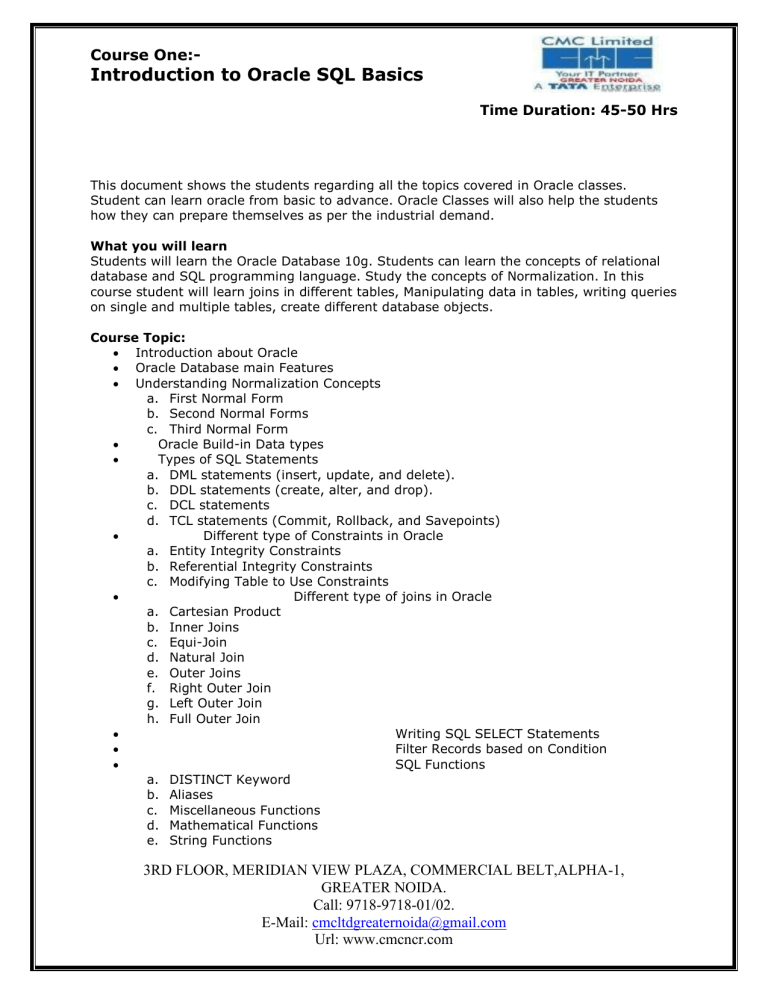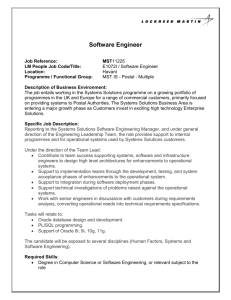Oracle SQL - CMC Greater Noida

Course One:-
Introduction to Oracle SQL Basics
Time Duration: 45-50 Hrs
This document shows the students regarding all the topics covered in Oracle classes.
Student can learn oracle from basic to advance. Oracle Classes will also help the students how they can prepare themselves as per the industrial demand.
What you will learn
Students will learn the Oracle Database 10g. Students can learn the concepts of relational database and SQL programming language. Study the concepts of Normalization. In this course student will learn joins in different tables, Manipulating data in tables, writing queries on single and multiple tables, create different database objects.
Course Topic:
Introduction about Oracle
Oracle Database main Features
Understanding Normalization Concepts a.
First Normal Form
Second Normal Forms
Third Normal Form
b.
c.
Oracle Build-in Data types
Types of SQL Statements a.
DML statements (insert, update, and delete). b.
DDL statements (create, alter, and drop). c.
DCL statements d.
TCL statements (Commit, Rollback, and Savepoints)
Different type of Constraints in Oracle
Entity Integrity Constraints a.
b.
Referential Integrity Constraints c.
Modifying Table to Use Constraints
Different type of joins in Oracle a.
Cartesian Product b.
Inner Joins c.
Equi-Join d.
Natural Join e.
f.
Outer Joins
Right Outer Join g.
Left Outer Join h.
Full Outer Join
Writing SQL SELECT Statements
Filter Records based on Condition
SQL Functions a.
DISTINCT Keyword b.
Aliases c.
d.
Miscellaneous Functions
Mathematical Functions e.
String Functions
3RD FLOOR, MERIDIAN VIEW PLAZA, COMMERCIAL BELT,ALPHA-1,
GREATER NOIDA.
Call: 9718-9718-01/02.
E-Mail: cmcltdgreaternoida@gmail.com
Url: www.cmcncr.com
Course One:-
Introduction to Oracle SQL Basics
Time Duration: 45-50 Hrs
f.
g.
Date Functions
Pseudo Columns in Oracle
a.
GROUP BY Clause b.
HAVING Clause c.
Order of a SELECT Statement
Oracle Set Operator
a.
Union b.
Union All c.
Intersect d.
Minus
SQL Operators
Selecting Distinct and Sorting data in SQL
Group functions in Oracle a.
Simple Selects b.
Comparison Operators c.
IN and NOT IN Operators d.
e.
BETWEEN Operator
The LIKE Operator f.
Logical Operators g.
IS NULL and IS NOT NULL h.
ANY i.
ALL
SQL Functions a.
Single Row Functions b.
Group Functions
Inserting Data into Multiple Tables
Simultaneously
Using Merge Command in Oracle
Write scripts to do queries and display
SQL*PLUS reports.
SQL Subqueries a.
Introduction of Sub query b.
Using a Subquery with a DML Statement c.
d.
Subquery Operators
Standard vs. Correlated Subqueries e.
Correlated Subquery Example f.
Predicate Operators
Oracle Reports through SQL
*PLUS a.
Report Features b.
Session Control c.
The SET Command d.
e.
The COLUMN Command
The BREAK Command f.
The COMPUTE Command
3RD FLOOR, MERIDIAN VIEW PLAZA, COMMERCIAL BELT,ALPHA-1,
GREATER NOIDA.
Call: 9718-9718-01/02.
E-Mail: cmcltdgreaternoida@gmail.com
Url: www.cmcncr.com
Course One:-
Introduction to Oracle SQL Basics
Time Duration: 45-50 Hrs
a.
Managing Database objects with Data Dictionary Views
USER_TABLES b.
USER_OBJECTS c.
USER_SEQUENCES d.
USER_TRIGGERS e.
f.
USER_SOURCE g.
USER_SYNONYMS h.
USER_CONSTRAINTS i.
USER_VIEWS
USER_TAB_COLUMNS j.
USER_COL_COMMENTS
More Database Objects a.
Views b.
Synonyms c.
Sequence
3RD FLOOR, MERIDIAN VIEW PLAZA, COMMERCIAL BELT,ALPHA-1,
GREATER NOIDA.
Call: 9718-9718-01/02.
E-Mail: cmcltdgreaternoida@gmail.com
Url: www.cmcncr.com



![Database Modeling and Implementation [Opens in New Window]](http://s3.studylib.net/store/data/008463861_1-79059dcf084d498c795a299377b768a6-300x300.png)


![Applied Database Techniques [Opens in New Window]](http://s3.studylib.net/store/data/008463862_1-d5f3c73cf631a09ff52e4e51f0e293e6-300x300.png)
